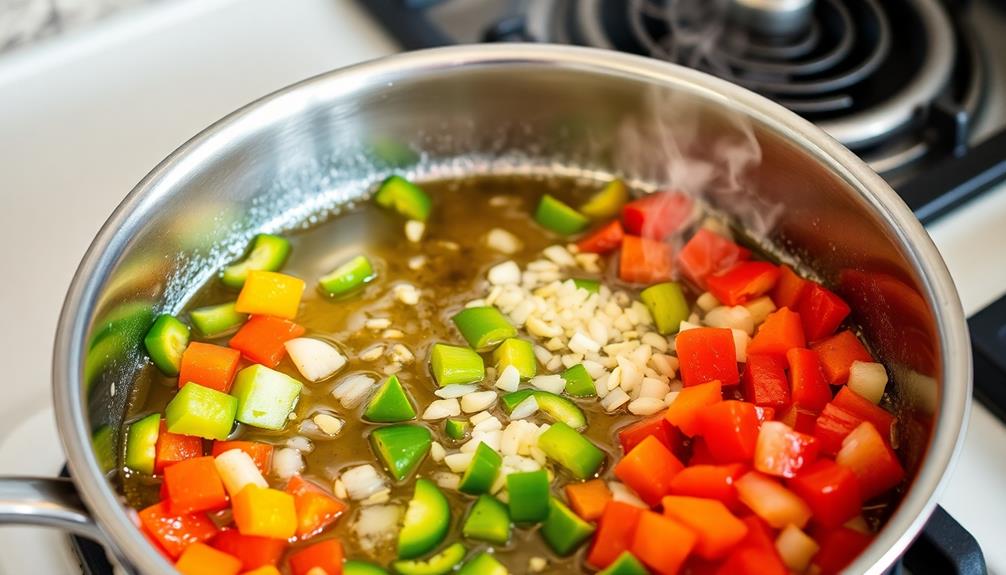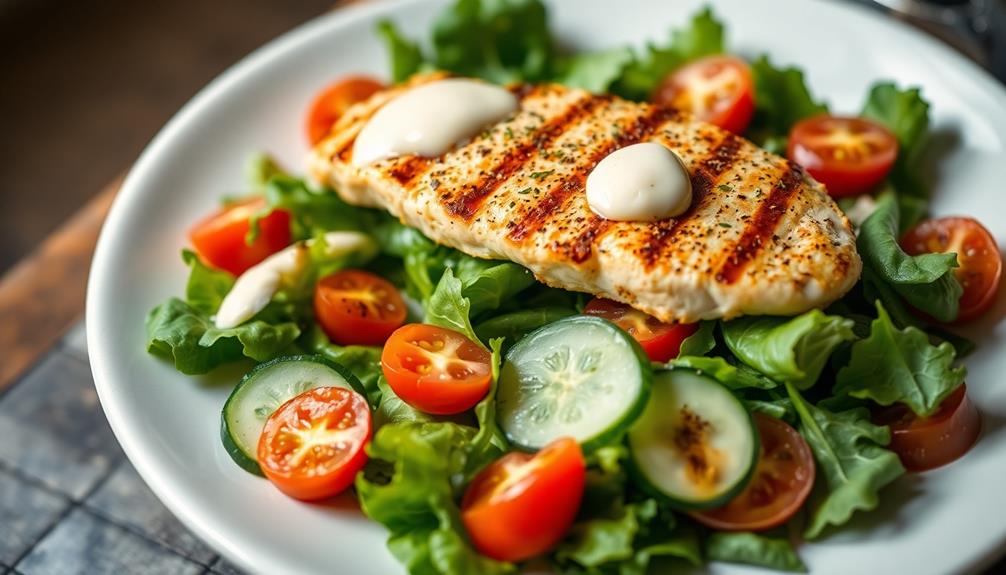Looking to combat chronic inflammation and boost your overall health? The anti-inflammatory diet might be just what you need! This approach emphasizes delicious whole foods packed with nutrients that can help reduce inflammation. From omega-3 rich fish and antioxidant-filled fruits and veggies to soothing spices like turmeric, this diet offers a bounty of flavorful options. By incorporating these anti-inflammatory ingredients into your meals, you can not only manage various health conditions but also improve your digestion and mental clarity. Curious to learn more about the cooking steps and lifestyle changes involved? Keep reading to explore the ins and outs of this transformative dietary approach.
Key Takeaways
- An anti-inflammatory diet focuses on whole, nutrient-dense foods rich in omega-3 fatty acids, antioxidants, and phytochemicals to reduce chronic inflammation.
- Common anti-inflammatory ingredients include fish, flaxseeds, fruits, vegetables, olive oil, and spices like turmeric and ginger.
- Adopting an anti-inflammatory diet can enhance overall health, support immune function, and lower the risk of chronic diseases.
- Meal preparation for an anti-inflammatory diet emphasizes fresh produce, lean proteins, and mindful cooking techniques to preserve nutrient content.
- Committing to an anti-inflammatory lifestyle requires patience, as the benefits often manifest gradually with consistent dietary changes.
History
The anti-inflammatory diet has its roots in ancient medicinal practices, with references to its principles found in traditional systems of healing across the globe. For centuries, people have recognized the power of certain foods to reduce inflammation in the body.
In ancient China, practitioners of traditional Chinese medicine used herbs and dietary changes to address inflammatory conditions. Similarly, Ayurvedic medicine from India has long emphasized the importance of a balanced, whole-foods-based diet to promote overall health and well-being.
As modern science has advanced, researchers have begun to uncover the mechanisms behind the anti-inflammatory properties of various foods. Studies have shown that compounds like omega-3 fatty acids, antioxidants, and phytochemicals can help to calm inflammation at the cellular level.
This growing body of evidence has led to the popularization of the anti-inflammatory diet in recent decades, as people seek natural ways to manage chronic inflammatory conditions and support their overall health.
Recipe
Eating an anti-inflammatory diet can help reduce chronic inflammation and improve overall health. Incorporating anti-inflammatory spices like turmeric and ginger not only enhances flavor but also provides significant health benefits; studies show Turmeric's potent effects can help reduce markers of inflammation.
This recipe for a delicious and nutritious anti-inflammatory meal is easy to prepare and packed with beneficial ingredients. The combination of fresh vegetables, lean protein, and anti-inflammatory spices creates a flavorful and satisfying dish that can be enjoyed any time of day.
This recipe is a great option for those looking to incorporate more anti-inflammatory foods into their diet. Packed with nutrient-dense ingredients like turmeric, ginger, and leafy greens, it not only helps reduce inflammation but also adds vibrant flavors to your meals. For those with special dietary needs, you can easily adapt this recipe by exploring cooking tips for food allergies to ensure it’s safe and enjoyable for everyone. Whether you’re meal-prepping or cooking for the family, this dish is both nourishing and versatile.
- 4 boneless, skinless chicken breasts
- 2 cups mixed greens (such as spinach, kale, and arugula)
- 1 cup sliced bell peppers
- 1 cup diced cucumbers
- 1/4 cup sliced red onion
- 2 tablespoons olive oil
- 1 tablespoon balsamic vinegar
- 1 teaspoon ground turmeric
- 1/2 teaspoon ground ginger
- Salt and pepper to taste
Preheat the oven to 375°F. Season the chicken breasts with the turmeric, ginger, salt, and pepper. Place the chicken on a baking sheet and bake for 25-30 minutes, or until the internal temperature reaches 165°F.
While the chicken is cooking, prepare the salad by combining the mixed greens, bell peppers, cucumbers, and red onion in a large bowl. Whisk together the olive oil and balsamic vinegar, then drizzle over the salad and toss to coat.
Once the chicken is cooked, slice it and add it to the salad. Serve immediately.
To enhance the anti-inflammatory properties of this dish, consider adding additional anti-inflammatory ingredients such as avocado, walnuts, or a sprinkle of ground cinnamon. Enjoy this flavorful and nourishing meal as part of a balanced anti-inflammatory diet.
Cooking Steps
First, gather your ingredients and chop them up.
Next, sauté the veggies in a bit of olive oil until they're nice and tender.
Then, add your spices and seasonings to give it all that delicious flavor.
Now, stir in the rice and let it simmer until it's perfectly cooked.
Step 1. Prepare and Chop the Ingredients

To prepare the ingredients for your anti-inflammatory diet, begin by carefully chopping up the fresh vegetables and herbs.
You'll want to wash them thoroughly and pat them dry before cutting. Dice the onions, mince the garlic, and chop the leafy greens like spinach or kale into bite-sized pieces.
Remember to use a sharp knife to ensure clean, even cuts. For the fruits, such as berries or citrus, gently rinse and slice or dice them as needed.
Don't forget to zest the lemon or orange if the recipe calls for it. As you prepare each ingredient, place them in separate bowls so they're ready to go when you start cooking.
This step might take a little extra time, but it'll make the actual cooking process much smoother and quicker. Plus, having all your ingredients prepped and within reach will help you stay organized and focused while you cook.
Step 2. Sauté Vegetables in Olive Oil

Next, heat a large skillet or sauté pan over medium heat and add a tablespoon or two of high-quality extra virgin olive oil.
Once the oil is hot, carefully add the chopped vegetables to the pan. Be sure to spread them out in an even layer so they can sauté properly.
As the veggies cook, use a spatula to stir and flip them occasionally. This helps them brown evenly and absorb the delicious olive oil flavor.
Sauté the vegetables for about 5-7 minutes, or until they're tender and starting to caramelize around the edges.
Now, you can add any additional seasonings you'd like, such as garlic, herbs, or a pinch of salt and pepper.
Gently toss the veggies to coat them in the spices. Continue sautéing for another minute or two, until everything is fragrant and well-combined.
Once the vegetables are cooked to your liking, remove the pan from the heat.
You're now ready to build your anti-inflammatory meal by adding the sautéed veggies to your dish.
Step 3. Add Spices and Seasonings

Now that the vegetables have been sautéed, it's time to add any desired spices and seasonings. This is where you can really bring out the flavors and make the dish your own.
Reach for your favorite dried herbs like oregano, basil, or thyme. A sprinkle of garlic powder, onion powder, or paprika can also add delicious depth.
Don't be afraid to get a little adventurous – try a dash of cumin, chili powder, or curry powder for some warmth and complexity. Freshly ground black pepper is a must to finish it off.
Stir everything together and let the aromas fill your kitchen. The key is to start with a small amount of each spice and adjust to your taste. That way, you can find the perfect blend that tantalizes your taste buds.
Have fun experimenting and find the flavors that make this dish sing!
Step 4. Add Rice and Simmer

Once the vegetables are seasoned, go ahead and add the rice. You'll want to use a long-grain white rice or brown rice for the best texture. Gently pour the rice into the pot, making sure to evenly distribute it throughout the vegetables. Give everything a good stir to combine the flavors.
Now, it's time to add the liquid. Pour in some broth or stock, enough to just cover the rice and veggies. Bring the mixture to a gentle simmer, then reduce the heat to low, cover the pot, and let it cook for about 20 minutes. Resist the urge to lift the lid and peek – you want to keep all that delicious steam trapped inside!
After 20 minutes, the rice should be tender and the vegetables will be nicely cooked through. Fluff the rice with a fork and serve hot. The combination of the aromatic spices, fresh vegetables, and hearty rice makes for a satisfying and nourishing anti-inflammatory meal.
Step 5. Garnish With Fresh Herbs

To finish off your anti-inflammatory dish, you'll want to add a few fresh herbs as a garnish. These vibrant green leaves not only look beautiful, but they'll also infuse your meal with an extra burst of flavor. Try sprinkling some chopped parsley, basil, or cilantro over the top. The fresh, herbal notes will complement the other ingredients perfectly.
Additionally, many of these herbs possess their own anti-inflammatory properties, enhancing the health benefits of your meal.
Don't be afraid to get creative with your herb choices. Maybe you'll want to try something a little different, like rosemary or thyme. Just make sure to chop the herbs finely so they're evenly distributed.
You can even try tearing the leaves with your fingers for a more rustic look.
The herbs will add a lovely pop of color and a refreshing finish to your anti-inflammatory dish. Plus, many herbs are packed with their own anti-inflammatory properties, making them a wonderful addition to your healthy meal.
Final Thoughts
The anti-inflammatory diet's true power lies in its ability to transform your overall health and well-being. By choosing nutrient-rich, whole foods, you'll nourish your body and reduce inflammation.
This approach isn't a quick fix; it's a lifestyle change that takes time and commitment. But the rewards are immense. As you incorporate more anti-inflammatory ingredients into your meals, you may notice increased energy, improved digestion, and even a boost in your mood.
Don't be discouraged if change doesn't happen overnight. Stick with it, and you'll start to see the benefits. Savor the delicious flavors, and enjoy the process of preparing wholesome, healing meals.
Frequently Asked Questions
How Can I Modify This Diet for a Vegetarian Lifestyle?
To modify this diet for a vegetarian lifestyle, focus on incorporating more plant-based anti-inflammatory foods like leafy greens, berries, nuts, seeds, and whole grains. You can also include plant-based protein sources and healthy fats to support your dietary needs.
What Are the Potential Side Effects of an Anti-Inflammatory Diet?
While an anti-inflammatory diet can be beneficial, you may experience side effects like gastrointestinal discomfort, changes in bowel habits, and potential nutrient deficiencies if you don't properly plan your meals. Always consult a healthcare professional before making significant dietary changes.
Can I Combine This Diet With Other Dietary Restrictions?
You can certainly combine an anti-inflammatory diet with other dietary restrictions, but it's essential to consult a healthcare professional to ensure the combined approach meets your nutritional needs and doesn't interfere with any existing medical conditions or treatments.
How Long Should I Follow an Anti-Inflammatory Diet for Optimal Results?
You should follow an anti-inflammatory diet for at least 4-6 weeks to see optimal results. The duration can vary depending on your health condition and individual response, but consistent adherence is key for reducing inflammation effectively.
Are There Any Supplements That Can Complement This Dietary Approach?
Supplements like omega-3 fatty acids, turmeric, and ginger can complement an anti-inflammatory diet by providing additional anti-inflammatory benefits. However, it's best to consult your healthcare provider before starting any new supplement regimen.










